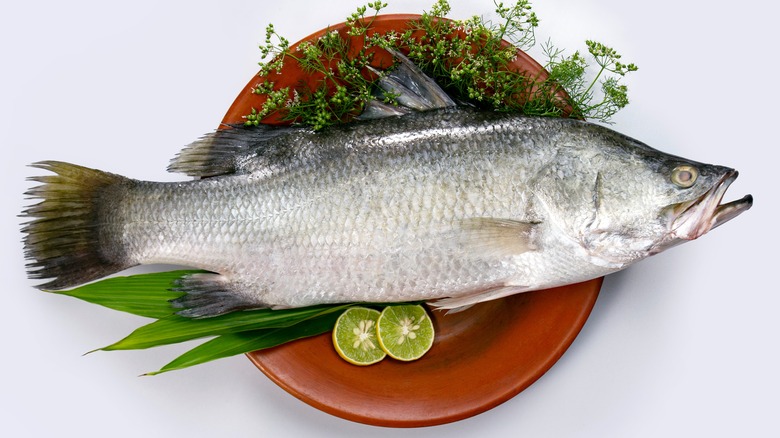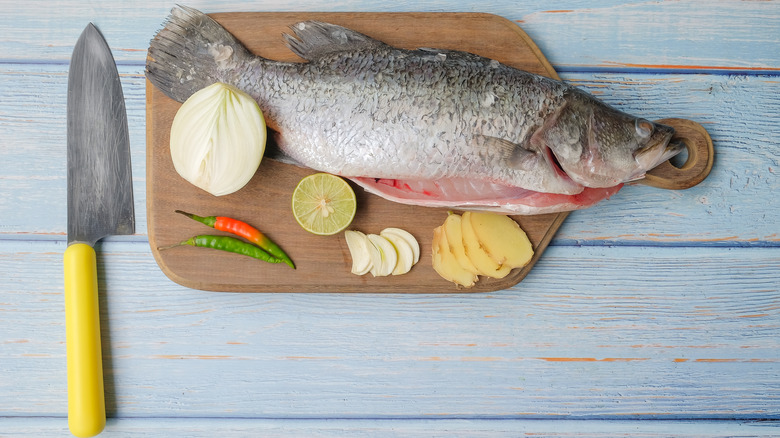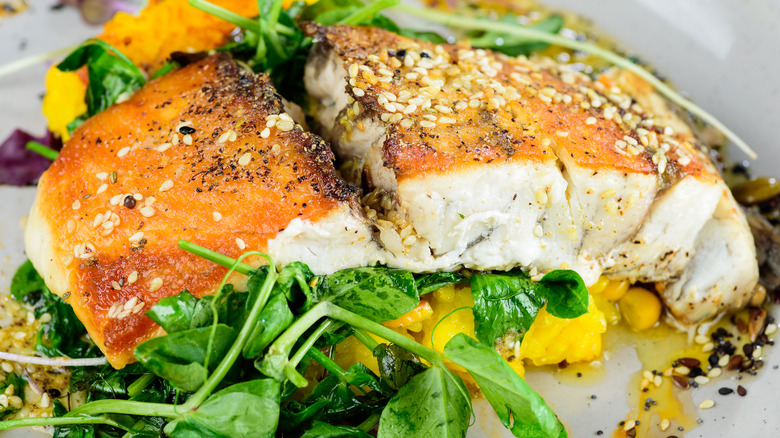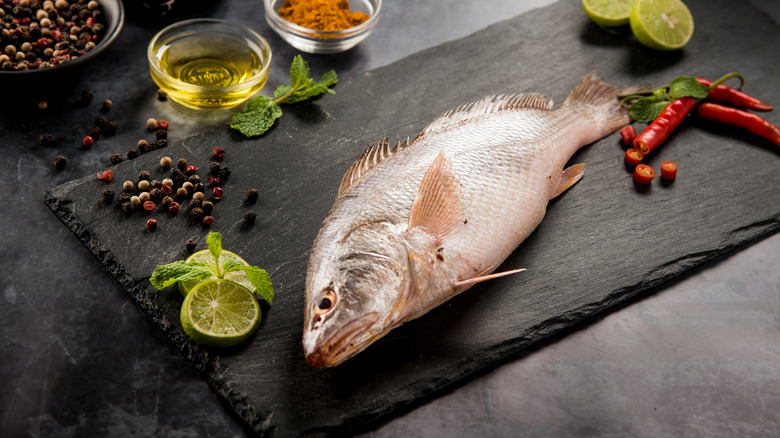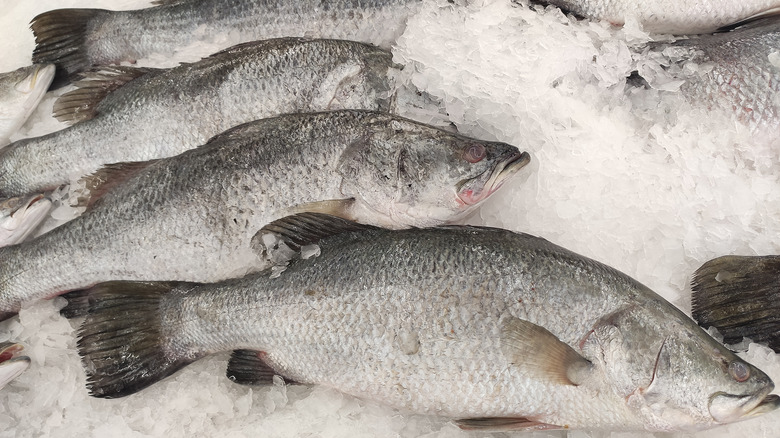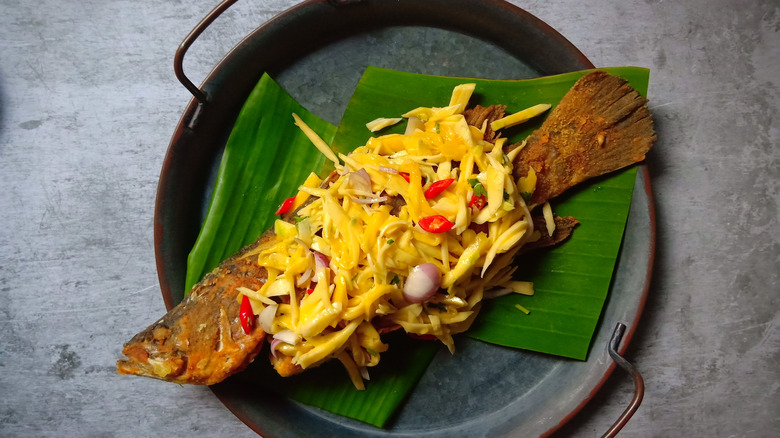What Is Barramundi And How Should You Cook It?
Seafood is one of the most important food groups, with the World Wildlife Fund reporting that over three billion people globally consume seafood as a main source of protein. Fish is one of the more widely consumed types of seafood, and there are countless varieties of fish out there, all with slightly varying flavor profiles.
With an estimated 30,000 types of fish, according to the National Park Service, odds are there are at least a few you're unfamiliar with. While you may know the largemouth bass, you may not have heard about barramundi or Asian sea bass. Barramundi is native to subtropical and tropical freshwater environments and is found in Australia, China, India, and the Persian Gulf, per All Things Nature. It's a popular sport fish, as well as an incredibly healthy and sustainable, eco-friendly meal option(via All Things Nature). If you want to learn more about barramundi, how to cook it, its health benefits, and more, keep reading.
What is barramundi?
Barramundi is heralded by health experts, climate activists, and chefs alike for its great taste, environmental friendliness, and dense amount of omega-3 fatty acids, according to WebMD.
All Things Nature reports that barramundi can weigh as much as 132 pounds, which makes them a popular species for sport fishing. Its scales are a grayish-green color with a silvery white underbelly, helping it blend into its murky river environment. The fish have bowed foreheads with rounded backs and pointed faces.
The barramundis are insect and fish-eating creatures, but a poor diet can lead to a poor-tasting meal, so most barramundis are grown in fish farms. This is another reason barramundi are considered quite sustainable. When fished for sport, they're often released due to their inadequate taste thanks to a less-than-ideal diet. Barramundis are found natively in rivers, lakes, and estuaries, as well as any other freshwater tropical or subtropical environments (via Native Fish Australia).
What does barramundi taste like?
If you're looking for a mild-tasting, easy-to-cook white fish with lots of protein, healthy fat, and other nutritional benefits, look no further than a filet of barramundi. According to The Better Fish, barramundi isn't as fishy or potent as other species like salmon. However, it still has a classic seafood flavor, similar in both texture and flavor to cod, tilapia, halibut, and other white fish.
Barramundi is described as having a very smooth flavor and texture — almost sweet, and a little buttery. It has a small amount of fat but enough oil to keep your fish moist with little effort when cooking, per SeafoodSource. Larger fish are reported to have a stronger flavor. It's a good fish for baking, steaming, or frying whole since there are a small amount of very easily removable bones. It's also very flaky, more so than salmon.
How to cook with barramundi
Cooking with barramundi is similar to cooking with any other white fish, and it can be used as an alternative to cod or tilapia in dishes like fish and chips or breaded, baked, grilled, or fried fish recipes. According to SeafoodSource, Aboriginal Australians cook barramundi by baking it in ginger leaves in hot ash.
Since the fish has a mild flavor and a naturally juicy and flaky texture, there are very few limitations on how to cook it. You can cook barramundi in any variety of ways, including steaming the fish, cooking it skin on for a crispy texture in contrast with the buttery flesh, roasting or baking the fish whole, pan-searing it, or even adding it to fish tacos, per Sydney Fish Market. Or, highlight and contrast the slight sweetness by grilling barramundi filets with a bit of lemon, pepper, and oregano (via Tasting Table).
Where to buy barramundi
Barramundi is a rather accessible fish due to the fact it's flash-frozen and shipped internationally. As The Better Fish explains, it's a much more economically and environmentally sound option to ship frozen fish over fresh, which makes it more accessible and affordable. You can find it frozen at popular grocery stores like Whole Foods in the frozen meats and fish sections.
Specialty online seafood retailers also sell frozen barramundi, either in filets, like this one from Anderson Seafoods, or whole, like this barramundi from R&T Asian Market.
If you're having a hard time finding frozen barramundi at your local grocery stores, try a seafood market or an Asian grocery store since the fish is native to south China, among other tropical and subtropical freshwater environments. If you're interested in trying freshly caught barramundi, you'll need to take a trip to a place like north Australia, per Fishing Booker. They're available to catch year-round, which is what helps make them so affordable when frozen and shipped, but that also means you can plan your fishing trip at any point of the year. Still, March through May are the best fishing months.
Nutritional information about barramundi
Barramundi is a popular fish for more than its climate-conscious farming method — it's also chock full of nutrients and a great addition to your diet. In general, many fish, including mackerel, salmon, herring, sardines, and anchovies, are heralded for their high amount of omega-3 fatty acids (via Healthline), and barramundi is no exception. As WebMD explains, omega-3s help reduce inflammation and increase heart health, and they can help stave off depression and memory loss.
This fish is also an excellent source of protein — according to LiveStrong, one 6-ounce filet of barramundi contains 35 grams of protein, which is as much as 76% of the CDC's recommended intake, making it a great way to get your protein all at once. It also has 40 milligrams of calcium, and as much as 4% of your recommended daily vitamin A intake. One serving size of barramundi contains 140 calories and 2 grams of unsaturated fat. If you're watching your cholesterol, keep a cautious eye on your barramundi intake since it's a little high in the compound — one serving has 70 milligrams, or 23%, of the average recommended intake.
